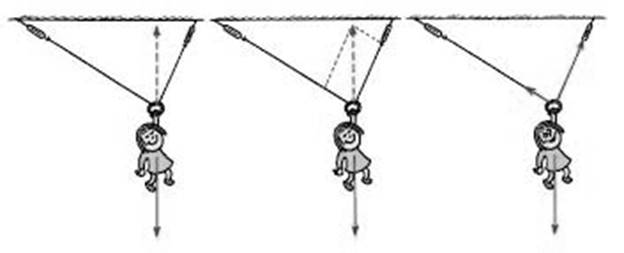
Concept explainers
When Nellie hangs from ropes at different angles, as shown in Figure 2.13, how does the vector resultant of the two rope tensions compare with her weight?
To compare: The vector resultant of the two rope tensions with person N weight.
Answer to Problem 20A
Weight of the person N and resultant of two rope tensions are equal in magnitude but opposite in direction.
Explanation of Solution
Given:
Person N is hanging from two ropes but making different angles. Other ends of the ropes are fixed.

Formula Used:
According to parallelogram law, the resultant of two vectors is
Calculation:
Person N weight will balance the tension in the two ropes. Tension in the ropes will vary either due to change in the position of person N or change in the angle between the two ropes with the vertical.
The resultant of two rope tensions is,
Where,
From the given diagram,
So,
Conclusion:
Therefore, person N weight is equal in magnitude of the resultant of two vectors but its acts in opposite direction.
Chapter 2 Solutions
Conceptual Physics C2009 Guided Reading & Study Workbook Se
Additional Science Textbook Solutions
College Physics: A Strategic Approach (3rd Edition)
Chemistry: An Introduction to General, Organic, and Biological Chemistry (13th Edition)
Organic Chemistry (8th Edition)
Human Physiology: An Integrated Approach (8th Edition)
Introductory Chemistry (6th Edition)
Biology: Life on Earth with Physiology (11th Edition)
- Those are the answers I got, can someone make sure they are correct?arrow_forwardNo chatgpt plsarrow_forwardQuestion 16 2.9 Three Pulleys 2.9a A thin, light rope is draped over three frictionless pulleys arranged around the origin as shown. Each pulley is a solid disk of radius r=2cm and is equidistant from the origin. 5kg mass is attached to one side and a 7kg mass to the other. Before the masses are released and in motion, what is the total angular momentum in kgm2/s around the origin? Question 17 2.9b What fraction of the angular momentum is in the pulleys?arrow_forward
- At what temperature would water boil if the outside pressure was only 19,900 Pa in degrees Celsius?arrow_forwardWhich of these properties of a sound wave is associated with the pitch of the sound that we hear? amplitudefrequency intensity levelintensityarrow_forwardA wave travels upward in a medium (vertical wave velocity). What is the direction of particle oscillation for the following? (a) a longitudinal wave parallel to the direction of propagationperpendicular to the direction of propagationarrow_forward
 College PhysicsPhysicsISBN:9781305952300Author:Raymond A. Serway, Chris VuillePublisher:Cengage Learning
College PhysicsPhysicsISBN:9781305952300Author:Raymond A. Serway, Chris VuillePublisher:Cengage Learning University Physics (14th Edition)PhysicsISBN:9780133969290Author:Hugh D. Young, Roger A. FreedmanPublisher:PEARSON
University Physics (14th Edition)PhysicsISBN:9780133969290Author:Hugh D. Young, Roger A. FreedmanPublisher:PEARSON Introduction To Quantum MechanicsPhysicsISBN:9781107189638Author:Griffiths, David J., Schroeter, Darrell F.Publisher:Cambridge University Press
Introduction To Quantum MechanicsPhysicsISBN:9781107189638Author:Griffiths, David J., Schroeter, Darrell F.Publisher:Cambridge University Press Physics for Scientists and EngineersPhysicsISBN:9781337553278Author:Raymond A. Serway, John W. JewettPublisher:Cengage Learning
Physics for Scientists and EngineersPhysicsISBN:9781337553278Author:Raymond A. Serway, John W. JewettPublisher:Cengage Learning Lecture- Tutorials for Introductory AstronomyPhysicsISBN:9780321820464Author:Edward E. Prather, Tim P. Slater, Jeff P. Adams, Gina BrissendenPublisher:Addison-Wesley
Lecture- Tutorials for Introductory AstronomyPhysicsISBN:9780321820464Author:Edward E. Prather, Tim P. Slater, Jeff P. Adams, Gina BrissendenPublisher:Addison-Wesley College Physics: A Strategic Approach (4th Editio...PhysicsISBN:9780134609034Author:Randall D. Knight (Professor Emeritus), Brian Jones, Stuart FieldPublisher:PEARSON
College Physics: A Strategic Approach (4th Editio...PhysicsISBN:9780134609034Author:Randall D. Knight (Professor Emeritus), Brian Jones, Stuart FieldPublisher:PEARSON





